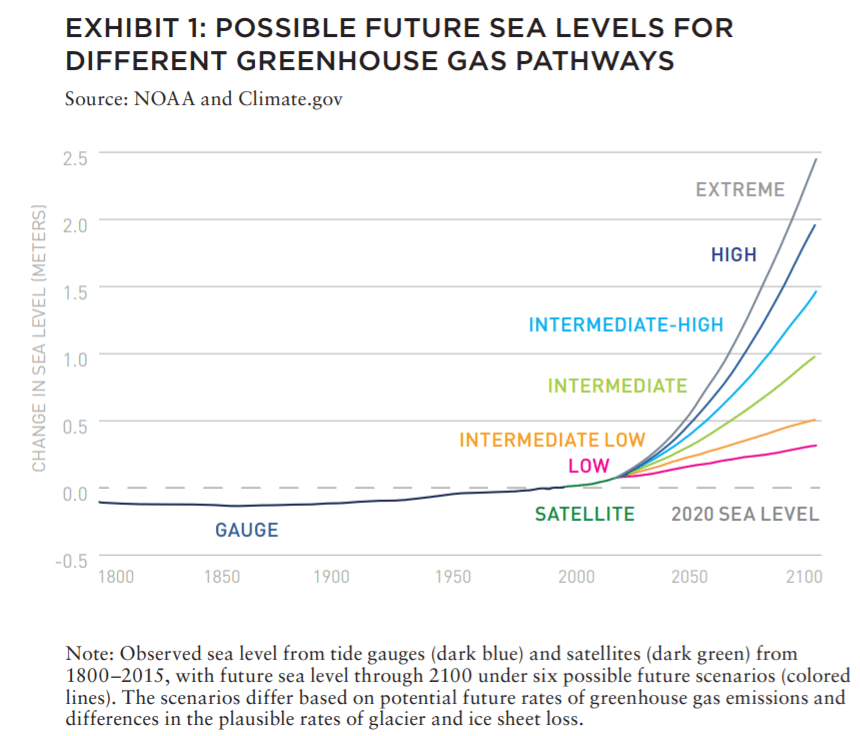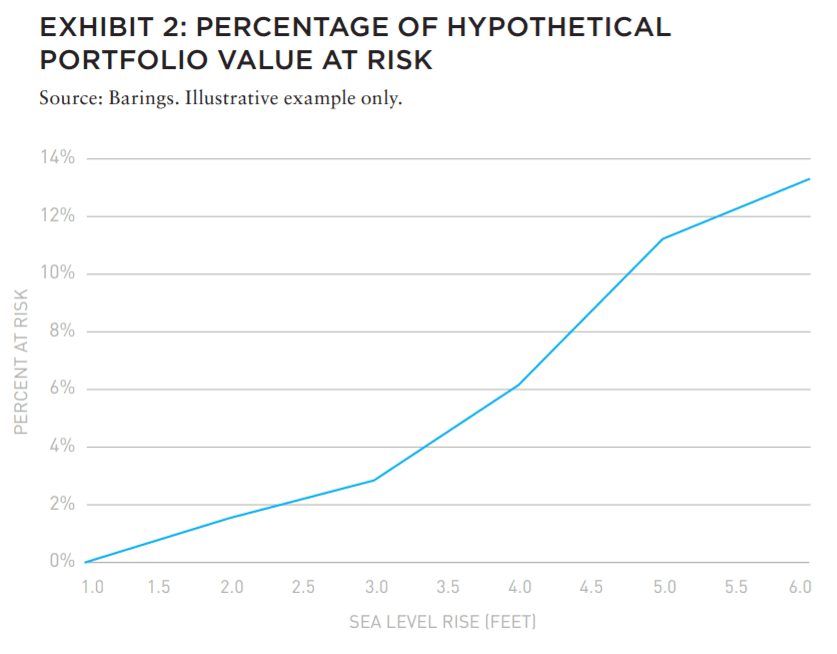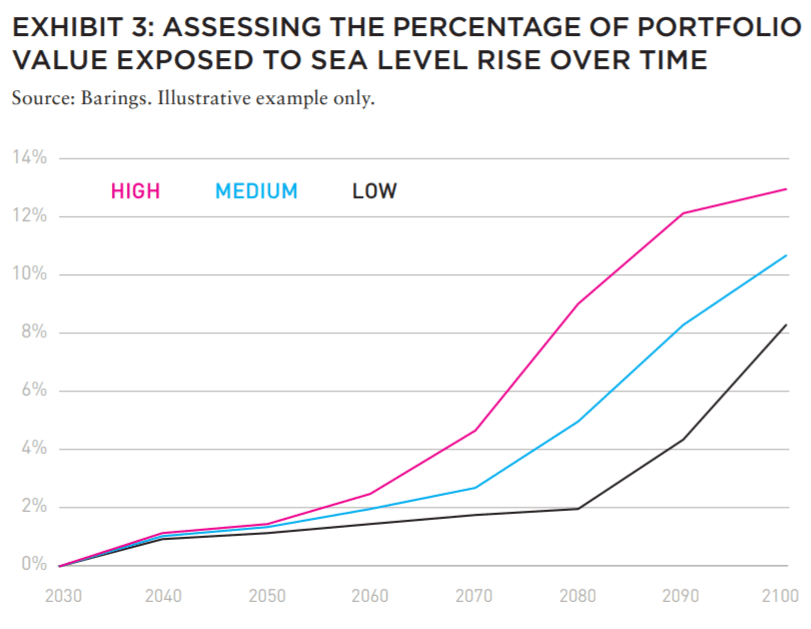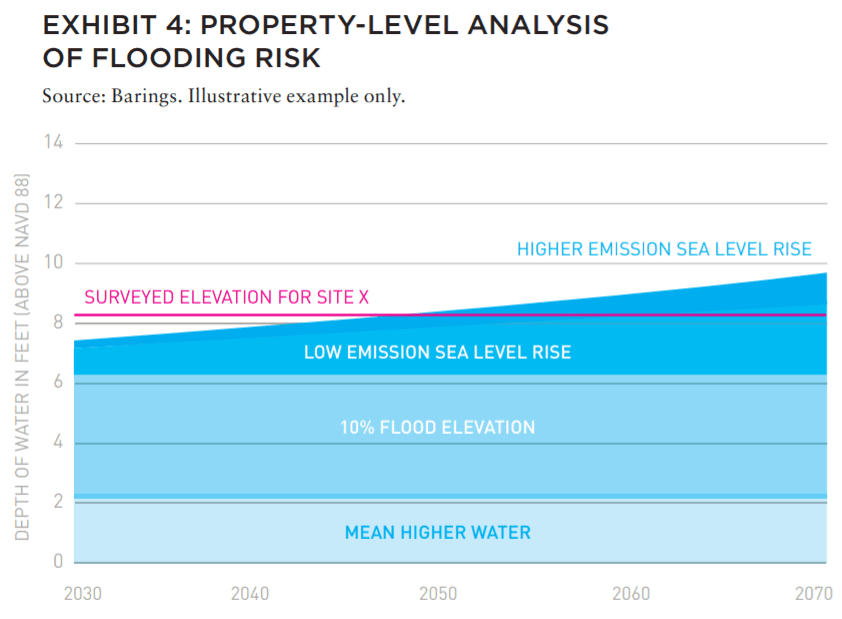Interest and excellence in ESG performance is becoming increasingly critical to portfolio strategy. So with sea levels on the rise, how can portfolios stay above water?
As investors focus more each day on environmental, social, and governance (ESG) considerations, one risk that should increasingly come into focus is the rise in sea levels globally. There is no longer much of a debate around if sea levels are rising—they are, and they’ve risen by eight inches globally since 1880, and faster since 1900, than in any preceding century for at least 3,000 years.1 But the evidence suggests that this pace is accelerating materially, with some areas along the US East Coast and Gulf of Mexico seeing eight-inch rises in the last fifty years alone.2
Today, the debate has moved from if to how fast sea levels will rise from here. This is a function of a variety of interrelated factors that include greenhouse gas emissions, global temperature rises, and the rate of melting ice. The National Oceanic and Atmospheric Administration (NOAA) has summarized the debate by publishing a hundred-year forecast incorporating the latest science. They forecast a twelve-inch global sea level rise by 2100 at the “low” level, and an approximately six-foot rise at the “high” level.
ASSESSING THE RISKS
From a real estate investor’s point of view, assessing the risk of such potentially dramatic changes can be a challenge, but steps can be taken to begin to quantify exposure and to mitigate risks. The risks to real estate assets range from periodic flooding to chronic inundation, which not only damage property but limit tenants’ ability to conduct business.
Eight of the world’s ten largest cities are in or near coastal areas—suggesting that the economic activity potentially at risk cannot be understated. In the US, almost 40% of the population is clustered in high-density coastal areas, which are prone to flooding, shoreline erosion, and hazards from storms.
Indeed, a recent NASA study indicates a rise of two feet above today’s sea level would put more than US$1 trillion of property and structures in the US at risk of inundation, with roughly half of that exposure concentrated in Florida.3
Other coastal states with large areas of low-lying land, including California, Louisiana, North Carolina, and South Carolina, also look particularly vulnerable to rising seas and coastal storm surges.
TIME FOR ACTION
Negative impacts to communities in these regions are almost certainly on the horizon, but there is hope. With some foresight and planning, it should be possible to reduce future losses through strategies that include mitigation and diversification.
While one might expect the impact from sea level rise to be gradual, experience suggests otherwise. More likely, the effects of sea level rise will be subject to “tipping points” triggered by such events as major storm surges from hurricanes, and the inundation of (or damage to) key infrastructure, such as ports, highways, bridges, and treatment plants.
Some jurisdictions are better suited than others to respond to inundation. In Manhattan, for example, the protected nature of the island, the intense urbanization, and the value of the real estate make the consideration of sea walls and mitigation efforts reasonable.4 For cities like Miami, however, there is no similarly reasonable solution. And in smaller communities, the available solutions may not prove cost effective even when feasible. Additionally, much uncertainty exists around who would pay for such solutions, and it would likely take years of political negotiations to structure tax plans and insurance policies to effectively protect at-risk properties. Managed retreat is an equally complex political problem, where consensus is nearly impossible.
MAKING A PLAN
With the dollar value of the potential risk so high, analyses of sea level risks are likely to strongly influence investment strategies with exposure to coastal areas in the coming decades. Tactically, there are actions that can be taken today to begin to quantify and mitigate such risks, including:
• ADVANCED MODELING: Through the use of increasingly sophisticated technology, property owners and investors can gain a better understanding of which buildings and market areas are most vulnerable.
• MONITORING ACCUMULATION: By leveraging the output of the models, property owners can focus on where to monitor accumulation most closely.
• PRE-ACQUISITION SEA-LEVEL RISE PROTOCOLS: Bolstering and strictly adhering to multi-step, pre-acquisition, sea-level risk analyses for properties in vulnerable areas should better inform pricing and acquisition decisions.
• BUILDING ABOVE CODE REQUIREMENTS: It is far cheaper to build to higher standards than to mitigate flood risk.
• PRUDENT ASSET MANAGEMENT: Judicious capital investment, suitable insurance programs, and informed emergency response plans to protect existing portfolio assets are crucial to helping tenants continue business without interruption through flooding events.
• PUSHING FOR SOLUTIONS: This can include everything from analyzing the cost and feasibility of solutions, such as seawalls, to advocating for revised zoning regulations.
• REDUCING EXPOSURE IN HIGH-RISK MARKETS: Properties in areas where tourism and recreation become less attractive—and other business activities become more cumbersome and expensive due to increased flooding risks— will likely represent less attractive investments over time, and therefore, will be strong candidates for divestment.
PUTTING THE PLAN INTO ACTION
To help understand how such analyses and mitigation plans are structured, it is worth a closer look at the process that is undertaken. As part of this closer look, the Barings Real Estate team has conducted sea level risk analyses and mitigation plans for multi-billion dollar real estate portfolios with broad exposure to coastal regions across hundreds of individual debt and equity investments.
The first step in assessing such risks is a three-part analysis conducted at the portfolio level:
• LEVEL 1: A site-level estimate of depth of flooding based on NOAA’s global sea level rise scenarios
• LEVEL 2: An analysis of the probabilistic exposure to sea level rise over time including low, moderate, and high estimates of sea level rise scenarios for 2030, 2040, 2050, 2060, and 2070
• LEVEL 3: A community-level risk assessment and accumulation estimate based on the tracking of at-risk markets for events and changes that may impact the entire market as opposed to a single asset
As a result of this analysis, it is possible to quantify the number of properties within the portfolio that are exposed to inundation risk based on the NOAA’s low-, medium-, and high-level scenarios. Of course, the dollar portfolio value that is actually exposed to such risk varies dramatically as scenarios change.
In the hypothetical example in Exhibit 2, for instance, a one-foot rise from current sea levels resulted in minimal property value exposure, but that exposure rose to approximately 13% of the portfolio under the six-foot rise scenario.
Looking at it another way, and taking into account NOAA’s various scenarios over multiple decades, the next step is to hone in on approximately when the risks begin to increase for the portfolio, as shown in Exhibit 3.
Finally, a property-level assessment is conducted for any asset considered “at risk” to provide more detail around which scenarios pose the greatest risks. This analysis takes into account not only the impact of global sea level rises, but also nuisance flooding, which is typically not deadly or dangerous, but can still have material impacts on a property values; for example, if a nearby bridge or road being inundated makes the property inaccessible. A sample visual of this analysis is shown in Exhibit 4.
In addition to quantifying and creating a more holistic understanding of the climate-related risks to the portfolio, this analysis also helps to inform an asset and portfolio management action plan that can be implemented immediately to begin to mitigate risks. Such actions include:
• Deployment strategies for temporary flood barriers (e.g., “Aqua Fence”)
• Relocating electrical equipment to higher elevations
• Building above code requirements
• Working with professional organizations and political institutions to effect change
• Reducing financial exposure to high-risk real estate markets
These actions not only have short-term benefits for specific properties, but they also can result in other positive downstream impacts, such as enhancing competitive positioning of properties among their peer set, diversifying portfolios, reducing insurance premiums, and most importantly, driving long-term value for investors. Importantly, although a given building may not be at immediate risk, the economic health of the entire community may be at risk, and thus, the commercial value of buildings is very likely to be impacted.
EXPANDING THE MODEL
The type of analysis shown here will only get more sophisticated, and by necessity, more common. As real estate investment managers fi eld increasingly detailed questions and grapple with increasingly stringent ESG-related requirements from their clients, being able to quantify and measure exposure to risks like sea level rise will be critical. While the scope of this article has been on this one risk, the same can be said for other critical areas like measuring and tracking the energy efficiency and carbon intensity of properties as well as creating pathways for these real estate assets to reach net zero carbon by 2050.
Ultimately, the ability for managers to meet these increasingly sophisticated investment requirements will come down to the quality of their systems. The time to invest heavily in technologies and systems—to measure, store, and analyze environmental metrics that can help to assess, and ultimately mitigate such risks—is now.
—
ABOUT THE AUTHORS
Jerry Speltz is Head of US Real Estate Engineering for Barings Real Estate. Barings is a $382+ billion global investment manager sourcing differentiated opportunities and building long-term portfolios across public and private fixed income, real estate, and specialist equity markets.
—
NOTES
* Barings Real Estate intentionally employs in-house engineers and insurance professionals, and further partners with specialty third-party consultants, to ensure appropriate attention to climate risk analysis.
1. Intergovernmental Panel on Climate Change, “Climate Change 2021,” August 2021, ipcc.ch/report/ar6/wg1/downloads/report/IPCC_AR6_WGI_SPM.pdf.
2. Rebecca Lindsey, “Climate Change: Global Sea Level,” ClimateWatch Magazine, August 2020, climate.gov/news-features/understanding-climate/climate-changeglobal-sea-level.
3. Union of Concerned Scientists, “Underwater: Rising Seas, Chronic Floods, and the Implications for US Coastal Real Estate,” June 2018, ucsusa.org/sites/default/files/attach/2018/06/underwater-analysis-full-report.pdf
4. Anne Barnard, “The $119 Billion Sea Wall that Could Defend New York…or Not,” New York Times, January 17, 2020, nytimes.com/2020/01/17/nyregion/seawall-nyc.html
ALSO IN THIS ISSUE (FALL 2021)
NOTE FROM THE EDITOR / GROUPTHINK VS. GROUP COLLABORATION
AFIRE | Benjamin van Loon
MID-YEAR SURVEY / CHECKING THE PULSE
No matter your age or experience, 2021 has shaped up to be a year that no one can forget. Findings from the AFIRE 2021 Mid-Year Pulse Survey detail a cautious road ahead.
AFIRE | Gunnar Branson and Benjamin van Loon
CLIMATE CHANGE / REASSESSING CLIMATE RISK
The commercial real estate industry may not yet fully grasp the actual relationship between climate risk and asset pricing and value. But the knowledge is coming fast.
York University | Jim Clayton
University of Reading | Steven Devaney and Jorn Van de Wetering
Kinston University | Sarah Sayce
UNEP FI | Matthew Ulterino
NON-TRADITIONAL / THE ALLURE OF SPECIALTY SECTORS
Real estate investments have historically coalesced around common property types—but it may make sense for investors to reconsider specialty property sectors in the post-COVID world.
Invesco Real Estate | David Wertheim
NON-TRADITIONAL / NON-TRADITIONAL IS GOING MAINSTREAM
The mainstreaming of nontraditional property types is well on its way within institutional investing, which will materially broaden the real estate investment universe.
Principal Real Estate Investors | Indraneel Karlekar, PhD
DIGITAL INFRASTRUCTURE / DIVERSIFYING INTO DIGITAL
As investors look for sustainable sources of inflation-protected yield, real estate investment is increasingly blurring into a wider range of “digital” real asset investment strategies.
AECOM Capital | Warren Wachsberger, Josh Katzin, and Corbett Kruse
LIFE SCIENCES / TAPPING INTO BIOTECH
Over the past two decades, the single-family rental industry haLife sciences real estate has been a “hot” property type for the past decade—and even more since the pandemic. Will all the capital targeting the space be placed where it needs to go?
RCLCO | William Maher, Ben Maslan, and Cecilia Galliani
ESG + CLIMATE CHANGE / HIGH-WATER MARKS
Interest and excellence in ESG performance is becoming increasingly critical to portfolio strategy. So with sea levels on the rise, how can portfolios stay above water?
Barings Real Estate | Jerry Speltz
ESG + NET-ZERO / VALUING NET-ZERO
With more tenants focusing on environmental targets, the burden to reduce direct emissions places increased pressure on investors, who are at a pivotal moment in ESG strategy.
JLL | Lori Mabardi, Emily Chadwick, and Eric Enloe
ESG + FAMILY OFFICE / FAMILY OFFICES AND ESG
As sustainable investing continues to grow in popularity, family offices have taken note—and understanding ESG targets and regulations will be key for longterm performance.
Squire Patton Boggs | Kate Pennartz and Rebekah Singh
DEBT / WHY DEBT, WHY NOW?
Debt funds remain a comparatively small part of the real estate investment market, but they have been gaining in prominence in recent years.
USAA Real Estate | Karen Martinus, Mark Fitzgerald, CFA, and Will McIntosh, PhD
MIGRATION / MIGRATION IN REAL TIME
As the public health situation started to improve in early 2021 and the economy reopened, did migration flows change too—and what if we are able to answer this in real time?
Berkshire Residential Investments | Gleb Nechayev
StratoDem Analytics | Michael Clawar
URBANISM / DOWNTOWN DISRUPTION
The pandemic-driven changes to downtown areas and central business districts is changing the geography of institutional investment. What else changes because of this?
Drexel University | Bruce Katz
FBT Project Finance Advisors + Right2Win Cities | Frances Kern Mennone
WORK-FROM-HOME / CHOOSING FLEXIBILITY
Employees are increasingly demanding flexibility and choice for where (and when) they work. What strategies can landlords implement to adapt?
Union Investment Real Estate | Tal Peri
TALENT AND RECRUITMENT / TALENT PARITY
To be better prepared for future risks, firms need diverse talent. So is the goal of 50% female representation achievable in global real estate investment and asset management firms?
Sheffield Haworth | Isabel Ruiz
CLIMATE CHANGE / PREDICTING THE CLIMATE FUTURE
We are all invested in the cities, assets, and infrastructure of tomorrow, even if we might not live to see the ten largest cities in 2100. But understanding climate change can get us closer.
Climate Core Capital | Rajeev Ranade and Owen Woolcock






